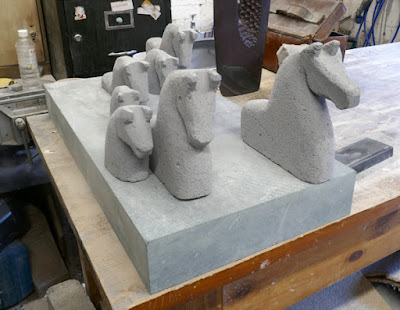The preparation of my talk to the Sheffield U3A Geology Group at the January indoor meeting, on the subject of metamorphic rocks, got 2023 off to a good start and I next turned my thoughts to the blocks of Rotherham Red sandstone that had been retained from excavation work for the new reservoirs behind Boston Park in Rotherham.
Having already contacted various members of staff at the Diocese of Sheffield, to inform them of a resource that could be potentially used for the repair of several churches built out of this locally distinctive sandstone, after being notified of these by Janet Worrall, I decided to follow up on her idea to have a sculpture made for Boston Park.
During a telephone conversation, she had informed me that Yorkshire Water had proposed Andrew Vickers of Stoneface Creative to do this but, having seen a lot of his work that I think is quite crude, I suggested that she might want to consider Steve Roche – a trained stonemason, letter cutter and sculptor, whose work I had seen at Malin Bridge.
The theme of the relief sculpture, which is carved on to a wall next to the River Loxley at the entrance to the Lidl supermarket, is the Great Sheffield Flood of 1864. Each of the items is taken from the reparation claims archive and are things that were important in local businesses and that people valued in their homes, with the grandfather clock being set to a few minutes to midnight - the time Dale Dyke Dam collapsed.
Ever since I was commissioned by the Royal Commission on the Historical Monuments of England (RCHME) in 1993, to photograph as many examples of post-war architectural sculpture that I could find, I have kept my eyes open for good examples of architectural sculpture on buildings of all ages and public sculpture wherever I go.
Ultimately, it was the decision of Janet Worrall and other members of the Friends of Boston Park and Castle to choose the artist for this project, but I had been campaigning for many years to get the excellent geology at Boston Park conserved and interpreted and I was therefore more than willing to help her with this.
All of this depended on obtaining funding to pay for it and, having been told that Yorkshire Water were making a significant payment to Rotherham MBC to make improvements to Boston Park, I decided to take the initiative and arranged to meet Steve Roche at his workshop at the Grade II Listed Stag Works on John Street in Sheffield.
Unlike textile manufacturing towns such as Halifax and Huddersfield in West Yorkshire, where the prosperity of the businesses is recorded in the very many magnificent Victorian stone buildings that are still seen in their town centres, the brick built back street industrial buildings of Sheffield are much more modest; however, the business owners were equally keen to promote their wares and it is good to see that this aspect of Sheffield’s industrial heritage is retained, instead of being replaced by soulless blocks of flats.
Over a cup of tea, I sat down with Steve to explain the situation with the blocks of Rotherham Red sandstone that had become available, a stone that he had not worked with before. I highlighted the fact that it is not a particularly hard stone and, containing variable quantities of clay ironstone nodules, would not be considered to be a first class stone.
With Steve making a deliberate decision in recent years to develop his calligraphic and letter cutting skills, it was not surprising to discover that Welsh and Cumbrian slate were his favoured materials and examples of these were lying around the workshop.
Having surveyed very many buildings constructed in Rotherham Red sandstone, although capable of being carved into gargoyles and grotesques, I knew that it wasn’t very suited to lettering and I was interested to learn that Steve had made the stags' heads sculpture that I had encountered at Cutlers Court during one of my walks in Sheffield.
The longer that I spoke to Steve about his various public sculpture projects and how e works with his clients, the more that I liked the approach to his work - particularly the Labyrinth Thumbprints, which I had also encountered when exploring Mosborough.
Although my own experience of working stone is limited to sawing White Mansfield, Ancaster Weatherbed, Ancaster Hard White and Chilmark for a few months at the Gregory’s Quarry for a few months, as a former building restoration contractor and a photographer of countless historic buildings and monuments, I could tell that Steve’s work is produced to a very high standard.
The Stag Works are now home to a very diverse range of businesses, with Steve’s small workshop not possessing the saws and lifting gear that are usually found in purpose built stone yards, but he seems to cope remarkably well and has close collaborators who can help him out if necessary.
Sharing a common passion for stone, we could have talked for hours but I didn’t want to take up more of his time, when Jane's good idea had not yet received financial backing. I had learned a few things and, as a geologist, I was very interested to see a sculpture that had been made out of purple Welsh slate, but which contained beds of green volcanic ash that is typically seen in the slates from Cumbria.
















No comments:
Post a Comment